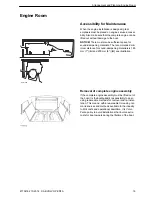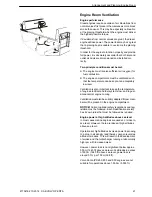
Engine Performance
Marine engine power is specified, just like automobile
and truck engines, according to one or more power
norms. Power is specified in kW or hp, always at a
rated rpm.
Most engines provide the power specified on the con-
dition that they have been tested in the conditions the
power norms state, and have been broken in properly.
According to ISO standards, tolerances are normally
±5 %, which is a reality that must be accepted for ser-
ies-produced engines.
Power measurement
Engine manufacturers normally measure engine
power at the flywheel, but before power reaches the
propeller, losses occur in the drive train and propeller
shaft bearings. These losses amount to 4–6 %.
All major marine engine manufacturers determine
engine power according to ISO 8665 (supplement to
ISO 3046 for pleasure boats). If an exhaust system is
not included, engine tests are performed with a back
pressure of 10 kPa (1.45 psi).
Engine performance
Engine power is affected by a number of different fac-
tors. Among the most important are air pressure, out-
door temperature, humidity, fuel calorific value and
exhaust back pressure. Deviations from normal values
affect diesel and gasoline engines in different ways.
Diesel engines use large amounts of air for combus-
tion. If the mass of air is reduced, the first sign is an
increase in black exhaust smoke. The effects of this
are especially noticeable at the planing threshold when
the engine must produce maximum torque.
If the deviation differs significantly from normal air flow,
the diesel engine will lose power. In the worst case the
loss may be so great that torque is insufficient for the
boat to overcome the planing threshold.
Point
A
is where the indicated engine power is equal
to the power acting on the propeller. Volvo Penta IPS
drive units have defined propeller sizes that are dimen-
sioned for engine characteristics.
1
2
3
4
5
6
A
B
C
P0004571
Connection between performance-influencing factors in inboard
engines
1
Power
2
rpm
3
Power loss due to atmospheric conditions
4
Loss due to large propeller
5
Critical area
6
Indicated rpm
Engine Characteristics, Engine Performance
47704162 10-2014 © AB VOLVO PENTA
15
Summary of Contents for IPS650
Page 1: ...IPS 2 IPS650 IPS800 IPS950 Installation 1 1 E ...
Page 2: ......
Page 156: ......
Page 160: ...47704162 English 10 2014 ...






























